chapter10 innate immunity
第十二章 细胞免疫(医学免疫学,人民卫生出版社第7版)
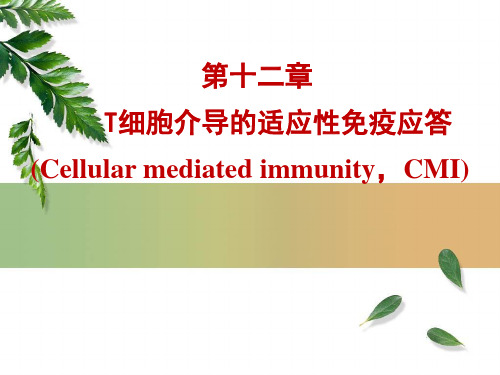
3)致死性攻击
CTL杀伤靶细胞存在细胞裂解和细胞凋亡两种方式, 以后者为主。CTL通过两条途径杀伤靶细胞
① 穿孔素/颗粒酶途径
穿孔素 颗粒酶
靶细胞膜穿孔 靶细胞膜不可逆性损伤
进入靶细胞 激活凋亡相关的酶系统 介导靶细胞凋亡
穿孔素(perforin)
② FasL/Fas途径、TNF-TNFR
活化CTL---FasL 靶细胞---Fas
IL-2是促进活化后T细胞增殖的最重要的细胞因子
1、CD4+T细胞的增殖和分化
初始CD4+T细胞
抗原
活化T细胞
表达多种细胞因子及受体
IL-2+IL-2R
T细胞克隆增殖
分化为Th0
IL-12,IFN-γ
IL-4
分化成Th1 分化成Th2
2、CD8+T细胞的增殖和分化
1. Th细胞依赖性 靶细胞一般仅低表达或不表达共刺激分子,
– 依赖Th:主要 为初始CTL
第三节 T细胞的免疫效应
一 Th和Treg的免疫效应 二 CTL的免疫效应 三 T细胞介导免疫应答的
生物学意义
一 、Th和Treg的免疫效应
(一)Th1细胞的效应
单个核细胞浸润为主 的炎症反应或迟发型炎症 反应
• 直接接触诱导CTL分化 • 释放CK募集和活化 Mo/Mφ、淋巴细胞,诱导 细胞免疫
辅助体液免疫 清除蠕虫䓁
哮喘等变态反 应性疾病
固有免疫
抗细菌、真菌和 病毒
银屑病、炎症性 肠病、多发性硬 化症、类风湿性
关节炎
辅助体液免疫 自身免疫
自身免疫性损 伤和疾病
负性免疫 调控
维持免疫 应答适度 性、防止 自身免疫
第15章固有免疫
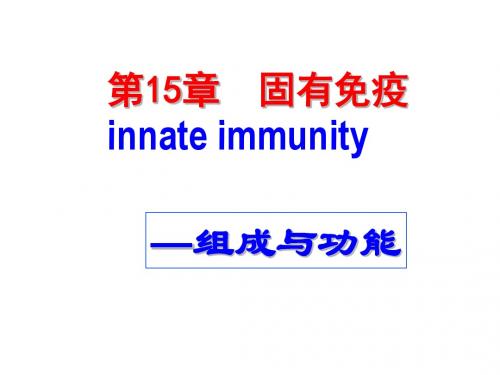
• 固有免疫的作用机制
– 通过免疫屏障阻止、干扰病原体的侵入、定居、繁 殖 – 诱发炎症反应,使补体、溶菌酶等物质形成炎症渗 出,直接杀菌; 吸引吞噬细胞、NK细胞等到达炎症反应部位,增 强对病原体的吞噬杀伤
– 通过DC的抗原递呈作用,激发T、B细胞活化,启 动特异性免疫应答
2、树突状细胞 (dendritic cells, DC)
• 典型树突状形态 • 功能最强的APC
3、NK细胞(Natural killer cells)
• 形态:胞浆内含大量嗜天青颗粒 • 标志:CD3-CD16+CD56+ • 杀伤特点:无需抗原致敏,直接杀伤靶细胞, 非特异性,非MHC限制性
– 固有免疫细胞
• • • • 吞噬细胞(单核巨噬细胞系统,中性粒细胞) 树突状细胞 自然杀伤细胞 B1细胞及γδ T细胞
– 多种体液成分
• 补体系统、溶菌酶、干扰素、C反应蛋白等
一、屏障结构 (barriers)
• 物理:皮肤、粘膜 • 解剖:血-脑、血-胎、血-胸 • 生物:粘膜表面正常菌群及杀菌抑菌 物质
– IgG Fc受体(FcγR) – 补体受体(C3bR/ C4bR)
单核巨噬细胞的生物学活性
• 吞噬和杀伤病原微生物及自身衰老凋亡细胞 • 释放多种生物活性物质,诱导炎症反应 • 抗原递呈作用
(2)中性粒细胞
• 吞噬杀伤抗原性异物
– – – – 无反应性氮中间物 (RNIs) 乳铁蛋白、阳离子蛋白、弹性蛋白酶 对抗胞外寄生菌感染,介导早期炎症反应 无抗原递呈作用
二、固有免疫的效应分子
• 补体 (complement)
• 溶菌酶 (lysozymes) • 细胞因子 (cytokines) • 抗菌肽 • 其他效应因子
免疫学固有免疫PPT课件
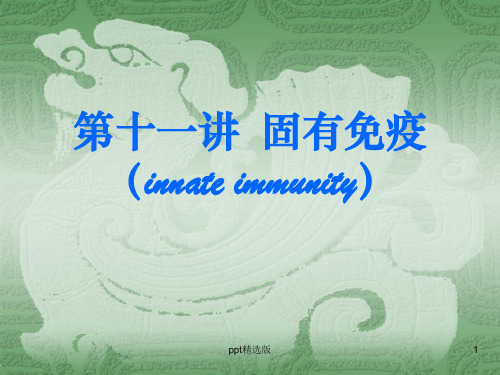
泪水/鼻纤 毛
化学屏障
脂肪酸
低pH
酶(胃蛋白 酶)
泪水中的酶 (溶菌酶)
抗菌肽
生物屏障
正常菌群
ppt精选版
8
3.内部屏障
(1)血-脑屏 障:软脑膜、脉
络丛的脑毛细血 管壁和包在壁外 的星形胶质细胞 所形成的胶质膜 共同组成。结构 致密
ppt精选版
9
(2)血-胎屏 障:母体子宫 内膜的底蜕膜 和胎儿绒毛膜 滋养层细胞共 同构成,阻止 母体内病原微 生物进入胎儿。
第十一讲 固有免疫 (innate immunity)
ppt精选版
1
固有免疫 (Innate Immunity) 先天免疫 (Native Immunity) 非特异性免疫 (Nonspecific Immunity)
获得性免疫 (Acquired Immunity) 适应性免疫 (Adaptive Immunity) 特异性免疫 (Specific Immunity)
固有免疫系统区别自我和非我的结构标志之一
ppt精选版
39
DAMP (damage associated molecular pattern,损伤相关的分子模式):凋亡,死亡,突变, 受损伤及老化的细胞,以及受损细胞所释放的 某些胞内组分(如热休克蛋白等).
ppt精选版
40
2.固有免疫识别方式:模式识别
导条理作用 CRP:结合细菌细胞壁磷酰胆碱
ppt精选版
42
2.巨噬细胞内吞型PRR:
甘露糖受体:识别结合甘露糖,岩藻糖残基, 介导吞噬作用
清道夫受体:结合细菌细胞壁某些组分,清 除血循环中的细菌
CD14:结合LPS
ppt精选版
43
粘膜免疫系统(英文)
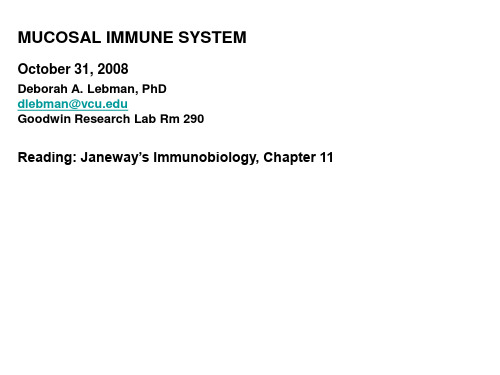
DENDRITIC CELLS FACILITATE ANTIGEN UPTAKE
LYMPHOCYTE CIRCULATION
You can come home again!!!
A COMMON MUCOSAL IMMUNE SYSTEM
Figure 10-20
Lymphocytes stimulated in mucosal sites traffic to mucosal sites
response to these antigens would do more harm than good
FEATURES OF THE MUCOSAL IMMUNE SYSTEM
THE MUCOSAL IMMUNE SYSTEM IS THE LARGEST SEGMENT OF THE BODIES IMMUNE DEFENSE MECHANISMS
LYMPHOCYTES ACTIVATED IN INTESTINAL TISSUES RETURN TO INTESTINAL TISSUE
B cell homing/recirculation is similar to that of T cells B cells and T cells are activated in “inductive” sites (PP, SLN) and specifcally traffic to effector sites (intestinal lamina propria
Regardless of whether cells have a:b or g:d TCR, they do not recognize antigen via MHC class I
They do not undergo thymic selection;many are self reactive Cytotoxic and express pro-inflammatory cytokines Innate immunity? NKG2D binds MICA and MICB which are elevated during
文学的召唤结构和其翻译中的再创造--以《红楼梦》的两英译本为例
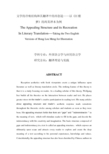
文学的召唤结构和其翻译中的再创造——以《红楼梦》的两英译本为例The Appealing Structure and its RecreationIn Literary Translation----Taking the Two EnglishVersions of Hong Lou Meng for Illustration学科专业:外国语言学与应用语言学研究方向:翻译理论与实践ABSTRACTReception aesthetics with fresh viewpoints exerts a unique influence upon literature as well as literary translation circle. The striking feature of this theory is that it is a study focusing on reader. As a leading scholar of this theory, Wolfgang Iser builds all his theories on the interaction between reader and text. He places greater stress on the reader‘s creative participation in reading text. His many articles about appealing structure and reader‘s aesthetic response made sensations throughout the theoretic circles among scholars and students as soon as they were born. His appealing structure holds that there are ―gaps‖ and“indeterminacies ‖ in the meaning of text,which will stimulate reader to fill in the gaps, and decode the indeterminacy with his creativity and imagination. The basic structure composed of gaps and indeterminacy in a text is called an appealing structure,which exposes an ultimately open scope and attracts every reader to explore and create the deep meaning of a text according to his personal experiences, knowledge and values. Coincidentally, the appealing structure has also been cherished by Chinese authors inlong literary history. Zhu Liyuan has made a thorough research on Iser‘s appealing structure, and extended his theory. He takes the view that the appealing structure should cover a broader area. According to their opinion, this dissertation mainly deals with the recreation of appealing structure from the perspective of reception aesthetics.Literature, an aesthetic reflection on real life, first and foremost must live up to the aesthetic standards. Literary translation as an art is in line with this standard, the ultimate aim of which is to satisfy readers‘aesthetic requirements. Literary translation entails a translator to cope with all kinds of questions arising from language, culture, author, text, reader, and so on. Literary translation is an actual recreation of aesthetic art, which is not only the wisdom of ancient translators, but also the common view of contemporary translators. Of course, the recreation is a limited creation fettered by the faithfulness to text and reader. Recreation covers a variety of areas and concerns many factors. Here, this dissertation, taking the two versions of Hong Lou Meng for illustration, mainly discusses the recreation of the appealing structures in the language in literary writings and in the meaning of a literary text for the purpose of reader reception.Firstly, the author deals with the recreation of the appealing structure in literary language. Undoubtedly, literary language is very significant, as it is the root of all the appealing structure such as meaning. Literary translation is an art of language, namely the art of reproduction and recreation in another language. When the original is translated, the appeal of source language will be lost to the target language reader. Only when target language appeal is reproduced, can it achieve the purpose of appealing the target language reader. In doing so, a translator should use the pure target language to substitute the pure source language, and strive to preserve the beauties of source language including its rhythm, fuzziness, indeterminacy and connotation. This doesn‘t exclude foreignized language, for it owns its appealing traits by breaking reader‘s habitual expectation horizon. Personally, in literary translation, domesticated language should be a main body, and the foreignized language, a supplement.The emphasis of this dissertation is laid on the recreation of textual meaning‘s appealing structure. Translation is to translate meaning; the whole process of translation is to treat meaning. Different from non-literary works, literary works are rich in gap, fuzziness, multi-meaning and indeterminacy. A translator is expected to recreate the original appealing structure in his translation. He, above all, should recreate the corresponding context and appealing open space in the chosen words and expressions, and meanwhile guard against the over-loaded translation and under-loaded translation. However, owing to the limitation of language, culture and translator himself, perhaps a translator can‘t identify the original appealing structure, and therefore make it lost or distort in his translation. Moreover, as one of the readers, a translator is likely narrow the appealing open space of the original, who will translate the indirect into the direct, the implicit into the explicit, and so on. If so, the target language readers would not appreciate the beauty hidden in the original as the source language readers do.In the recreation of the appealing structures in the literary language and textual meaning, a translator should bear the notion of reader need in mind, which would influence his adoption of words, and make his version different. The immediate aim of literary translation is to endow reader with aesthetic enjoyment by enabling him to decode the text through reading process. According to reception aesthetics, literary works are created by both author and reader. Comparatively, reader more than plays a crucial part in literary recreation; he is an actual pivot of the whole recreation. It is unimaginable for a literary work to survive without reader participation. So, when reader need clashes with the original, a translator should translate flexibly to cater to reader. It is no exaggeration that the importance of reader overrides other factors affecting translation. However, t his doesn‘t deny the fact that literary translation is a limited recreation on the condition that it should be faithful both to reader and author. Undoubtedly, reader reception is so important that the focus of literary translation in 21st century will be shifted to reader.Hong Lou Meng is known to every household with universal praise, whose glamour and popularity lie in its limitless appealingness. In this dissertation, takingthe two versions of Hong Lou Meng for illustration, the author made a tentative pursuit into the recreation of the appealing structures in literary language and textual meaning for the sake of the reception of reader from the perspective of reception aesthetics. To summarize, in this dissertation, ―recreation‖ is the focus, and ―reader reception‖is the target, with the ―translator subjectivity‖as a prerequisite and the ―faithfulness‖as a constraint. These aspects are correlated intrinsically and integrated into an organic whole unit.Key words: literary translation; reception aesthetics; recreation appealing structure; expectation horizon;appealingness内容摘要接受美学一产生,就在国内外文艺理论界激起巨大的反响。
10_innate_immunity免疫学--固有免疫
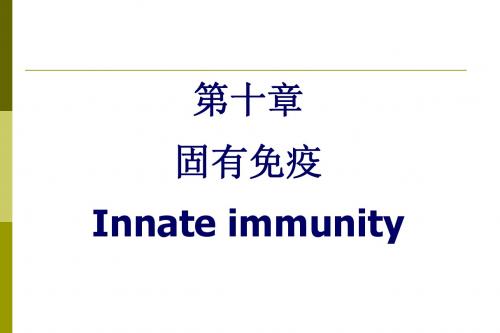
Phagocytes
Mononuclear Phagocytes
Monocytes in Blood
Macrophages in tissue△
Neutrophils
机体抗感染免疫的主要细胞。
具有IgG Fc受体和C3b受体,具有ADCC效应。
单核-巨噬细胞 (mononuclear macrophage)
4、processing and presentation of antigen
加工提呈抗原,启动适应性免疫应答 5、Immune regulation 免疫调节
自然杀伤细胞 (natural killer cell, NK cell)
P139
Natural Killer cell
•Location:Mostly in Blood and Spleen
35
How NK distinguish “self and non-self” ?
→Normal tissue cells →Virus-infected cells and tumors
“I have receptors on my surface^_^ ”
36
Function
杀伤细胞活化受体 杀伤细胞抑制受体
Toll
like receptors are a family of proteins of which there are at least 10 known members.
TLRs, innate immune cells can detect and respond to infection by recognizing conserved motifs of microbes. transmit signals about microbial constituents to the nucleus, thus regulating the type of genes expressed, and the subsequent response.
浅析染色质免疫沉淀(ChIP)技术在DNA与蛋白质相互作用研究中的重要性

浅析染色质免疫沉淀(ChIP)技术在DNA与蛋白质相互作用研究中的重要性染色质免疫沉淀(ChIP)是研究蛋白质-DNA相互作用的一项强大技术,广泛用于多个领域的染色质相关蛋白的研究(如组蛋白及其异构体,转录因子等),特别适用于已知启动子序列或整个基因位点的组蛋白修饰分析研究。
这项技术采用特定抗体来富集存在组蛋白修饰或者转录调控的DNA片段,通过多种下游检测技术(定量PCR,芯片,测序等)来检测此富集片段的DNA序列。
ChIP技术自诞生之后,已成功的应用于人或动物细胞和组织[1] 、植物组织[2]、酵母[3] 以及细菌、质粒[4] 。
由于在信号转导和表观遗传研究中的突出作用,ChIP 在肿瘤[5-7]、神经科学[8-10]、植物发育[11-13] 等领域中应用非常广泛,同时有关细胞凋亡[14]、雌激素信号转导[15] 、胰岛素抵抗[16] 、组织发育[1]的文献中也用到ChIP。
目前,最常见的有以下两种ChIP实验技术:1. nChIP:用来研究DNA及高结合力蛋白,采用微球菌核酸酶(micrococcal nuclease)消化染色质,然后进行片段富集及后续分析,适用于组蛋白及其异构体,例如[17-19] ;2. xChIP:用来研究DNA及低结合力蛋白,采用甲醛或紫外线进行DNA和蛋白交联,超声波片段化染色质,然后进行片段富集及后续分析,适用于多数非组蛋白的蛋白,例如[9, 15, 20]。
X-ChIP试验的一般过程以上两种方法在分离DNA-蛋白质复合物之后,对DNA进行PCR扩增,验证目标序列的存在。
除验证实验外,ChIP DNA也可以进行测序分析,这种方法被称为ChIP-seq[22];也可做芯片分析,这种方法被称为ChIP on CHIP或ChIP-CHIP[23] 。
这两种方法都可用于分析感兴趣蛋白结合的未知序列,而不需要知道目标序列的详细信息,因此可以进行探索性的研究。
当需要对DNA结合的蛋白复合物(两个或两个以上蛋白共同结合在DNA上)进行研究时,可以采用reChIP技术对DNA蛋白复合物进行再次富集,从而分析两种蛋白同时结合的DNA片段,例如转录调控因子及其受体复合物[24]。
补体系统-(2)ppt课件

第一节 概 述
补体系统是由存在于人或脊椎动物血清与组织液中的一组可溶性蛋白及存在于血细胞与其它细胞表面的一组膜结合蛋白和补体受体所组成。 在机体的免疫系统中担负抗感染和免疫调节作用, 并参与免疫病理反应。 补体是天然免疫(Innate immunity)的重要组成部分
补 体 活 化 的 经 典 途 径
IgM/IgG -Ag复合物
C1q : r : s
C4
C4b + C2
C4a
C2a
C4b2b
C3
C3b
C3a
Ca++
Mg++
Ca++
(C3转化酶)
C4b2b3b
(C5转化酶)
识别
活化
C5
C5b-C6,7,8,9
C5a
细胞溶解
攻击
Fab段
Fc段
暴露的C1q结合位点
(六)C9, 穿孔素(Perforin) C9和穿孔素结构类似,均为单链结构, N端以亲水性氨基酸为主,C端均以疏水性氨基酸为主。被活化后形成管状结构的多聚体,由10个以上的单体分子组成,可通过其疏水性的C末端插入细胞膜,导致细胞溶解。
N
C
凝血酶
亲水区
疏水区
三 补体系统的激活途径
(一)经典途径: 几个特点: 1 抗原抗体特异结合活化 2 反应顺序为C1qrs-C4-C2-C3-C5-C6-C7-C8-C9 3 产生3个转化酶:C1酶, C3转化酶,C5转化酶 4 产生3个过敏毒素(Anaphylatoxin),C3a, C4a,C5a
4 补体固有成份是由肝细胞、巨噬细胞、 肠 粘膜上皮细胞和脾细胞等合成的糖蛋白,含量约占血清球蛋白总量的10%,其中C3含量最高、D因子含量最低。 5 固有成份间的分子量差异较大,其中C1q 最大、D因子最小。 6 对热不稳定,56°C、30min即被灭活,0~10 °C条件下活性只能保持3~4d。 7 多种理化因素如射线、机械振荡、酒精、胆汁和某些添加剂等均可破坏补体
免疫学概述
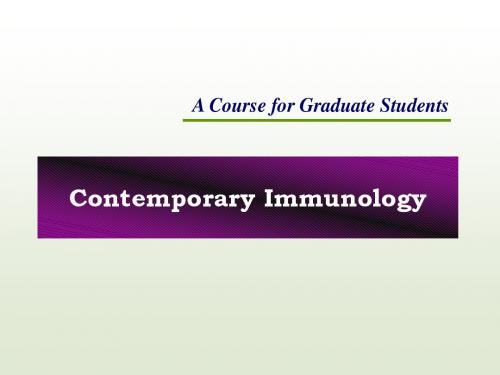
1688年(康熙27年)俄国派人来华学种痘; 1718年 英驻土尔其公使夫人Montagu将人痘 接种带往英国; 1722年 Boston医生马瑟在北美推广种痘; 1752年《医宗金鉴》传入日本,带去种痘法; 1777年 华盛顿命令美国全军将士种痘。
牛痘接种 (vaccination with cowpox)
Chapter 1: Overview
1
Historical retrospect: Immunology and Infectious Diseases
Violent infectious diseases as disasters for mankind: yellow fever, plaque, cholera, smallpox, flu
germ-line;
The materials encountered by the immune
system at early stages of its development
The materials encountered by the immune system at the early stage of its development could be regarded as „SELF‟.
皇祖母
( 博尔济吉特)
顺治
(福临)
1637-1661
康熙
(玄烨)
1653-1722
康熙:庭训格言(1689年) 国初,人多畏种痘、至朕得种痘方, 诸子女皆以种痘得无恙。今四十九旗…… 俱命种痘,凡所种者皆得善愈。尝记,初 种豆时,年老人尚以为怪。朕坚意为之, 遂全此千万人之生者,岂偶然耶?
人痘接种(viriolation)
外周免疫 器官和组织
好习惯成就好习惯人的英语作文

Good habits are the cornerstone of a persons character and success in life.They not only shape our daily routines but also influence our longterm achievements and wellbeing. Heres a detailed look at how good habits can lead to the formation of a wellrounded individual.Importance of Good Habits1.Health Benefits:Regular exercise,a balanced diet,and adequate sleep are good habits that contribute to physical health.They help in maintaining a healthy weight,boosting immunity,and ensuring a good nights rest,which is essential for overall health.2.Mental Wellbeing:Habits like meditation,reading,and continuous learning contribute to mental wellbeing.They help in reducing stress,improving focus,and expanding knowledge,which are crucial for cognitive development.3.Time Management:Good habits such as punctuality and planning help in effective time management.They ensure that tasks are completed on time,reducing the stress associated with lastminute rushes and missed deadlines.4.Financial Stability:Habits like saving money,budgeting,and investing wisely contribute to financial stability.They help in building an emergency fund,achieving financial goals,and securing a comfortable future.5.Social Skills:Good habits like active listening,empathy,and effective communication enhance social skills.They foster better relationships,improve teamwork,and contribute to a positive social environment.Formation of Good Habits1.Awareness:The first step in forming a good habit is being aware of its importance. Understanding the benefits of a habit can motivate one to adopt it.2.Consistency:Consistency is key to forming a habit.It requires daily practice and commitment to the habit until it becomes a natural part of ones routine.3.Small Steps:Starting with small,manageable steps can make the process of habit formation less daunting.For example,starting with a10minute exercise routine can lead to longer and more intense workouts over time.4.Environment:Creating a conducive environment can support the formation of goodhabits.For instance,keeping a workspace organized can encourage productivity.5.Accountability:Having a support system or using tools like habit trackers can provide accountability,which is essential for maintaining new habits.Challenges and Solutionsck of Motivation:Sometimes,the lack of immediate results can demotivate individuals.Setting shortterm goals and celebrating small victories can help maintain motivation.2.Procrastination:Procrastination can hinder the formation of good ing techniques like the Pomodoro Technique or breaking tasks into smaller parts can help overcome procrastination.3.Distractions:Distractions can divert attention from the habit formation process. Identifying and eliminating common distractions can create a more focused environment.ck of Time:Many people feel they lack the time to form new habits.Prioritizing and integrating new habits into existing routines can help find the time for habit formation.ConclusionGood habits are the building blocks of a successful and fulfilling life.They require awareness,consistency,and a supportive environment to be formed.Overcoming challenges like lack of motivation,procrastination,and distractions can be achieved through various strategies.Ultimately,the formation of good habits leads to personal growth,improved health,and a more productive lifestyle.。
innate immunity
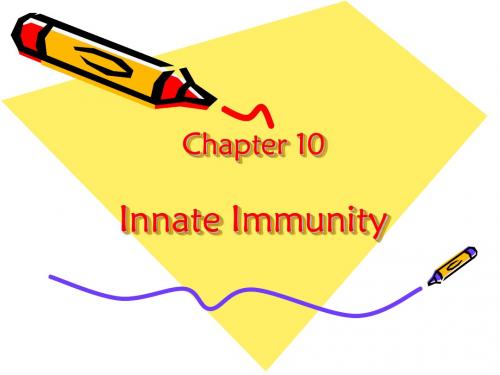
PartⅡ Cells participating in innate immunity
Ⅰ. Natural killer(NK)cells
1. Source: Bone marrow,exist mainly in peripheral blood(5-7%) and spleen.
2. Characteristics of NK cells
PartⅠ Components of innate immune system
Ⅱ.Humoral factors:
Complement Cytokine---macrophage, neutrophil, NK cell Lysozyme
Ⅲ. Cells:
Mononuclear phagocyte, NK cell, Neutrophils, Dendritic cells,Eosinophil, Basophil, Mast cell, γδT cell, B1 cell, Microfold cell
KIR: KIR2DS,KIR3DS
KLR: CD94/NKG2C NKG2D NKp46 NKp30 NCR NKp44
KIR2DL,KIR3DL
CD94/NKG2A
Bind non-class I HLA molecules
Figure 3-23
These are important molecules for presentation of peptides to CD8 T cells
• Killer activating receptor and killer inhibitory receptor
ADCC
Receptors associated with killer activation and killer inhibition on NK cells
参与固有免疫应答的细胞(模板参考)
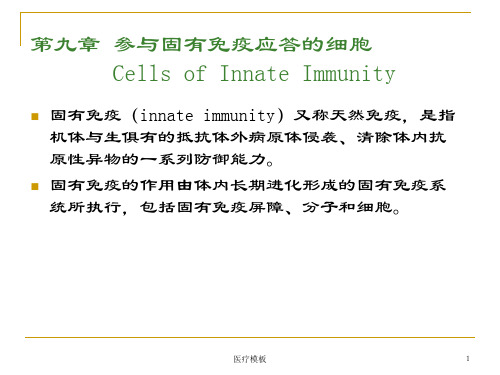
医疗模板
19
医疗模板
20
一般来说,经由TLR传递的信号主要引起细胞因子的 合成和分泌,诱发炎症反应并介导巨噬细胞和中性 粒细胞向炎症部位浸润。
TLR信号还能够募集活化NK细胞、树突状细胞,促进 DC细胞向T细胞提呈抗原,启动T细胞应答。
活化T细胞产生的细胞因子(如IFN-)又进一步活 化单核吞噬细胞,因此借助TLR的桥梁作用,固有性 免疫和适应性免疫就被紧密联系起来了。
医疗模板
21
(四)单核吞噬细胞的生物学功能
单核吞噬细胞是固有免疫的执行者,是适应性免疫发 挥作用前机体防御病原性异物侵袭的重要机制。
MyD88是TLR家族成员所共有的接头分子。
医疗模板
18
MyD88依赖性信号途径的基本过程如下:以TLR4为 例,LPS和LPS结合蛋白(LBP)形成的复合物与 CD14结合后,使细胞表面的TLR4受到刺激形成同 源二聚体,并在分泌性因子MD-2的协助下活化, 活化的TLR4通过其TIR功能域与接头蛋白MyD88的C 端TIR相互作用,再利用MyD88 N端的死亡功能域 (DD)募集胞浆中含有死亡功能域(DD)的丝氨 酸/苏氨酸激酶——IL-1受体相关激酶(IRAK)。
医疗模板
22
1、单核吞噬细胞吞噬和清除病原微生物
其基本过程如下:
第一步,在病原微生物等抗原作用后,为静止的 单核巨噬细胞提供活化信号,并诱导单核巨噬细 胞向应答部位聚集,这一过程称为趋化
第二步,病原微生物通过其抗原与PRRs等的作用 粘附在单核巨噬细胞表面。黏附作用诱导单核巨 噬细胞的胞膜突出形成伪足,将抗原包绕起来, 伪足融合,病原体抗原则以膜包结构方式被摄入 细胞内形成吞噬体(phagosome);
检测基因实用指南说明书

Reporter Genes A Practical GuideM E T H O D S I N M O L E C U L A R B I O L O G Y™John M. Walker,S ERIES E DITOR436.Avian Influenza Virus, edited byErica Spackman, 2008435.Chromosomal Mutagenesis, edited by Greg Davis and Kevin J. Kayser, 2008434.Gene Therapy Protocols: Vol. 2:Design and Characterization of Gene Transfer Vectors,edited by Joseph M. LeDoux, 2008433.Gene Therapy Protocols: Vol. 1: Production and In Vivo Applications of Gene TransferVectors, edited by Joseph M. LeDoux, 2008 anelle Proteomics, edited byDelphine Pflieger and Jean Rossier, 2008 431.Bacterial Pathogenesis:Methods andProtocols,edited by Frank DeLeo andMichael Otto, 2008430.Hematopoietic Stem Cell Protocols,edited by Kevin D. Bunting, 2008429.Molecular Beacons: Signalling Nucleic Acid Probes, Methods and Protocols, edited byAndreas Marx and Oliver Seitz, 2008428.Clinical Proteomics: Methods and Protocols, edited by Antonio Vlahou, 2008427.Plant Embryogenesis, edited by Maria Fernanda Suarez and Peter Bozhkov, 2008 426.Structural P roteomics:High-Throughput Methods,edited by Bostjan Kobe,Mitchell Guss, and Huber Thomas, 2008 425.2D PAGE: Vol. 2:Applications and Protocols, edited by Anton Posch, 2008424.2D PAGE: Vol. 1:Sample Preparation and Pre-Fractionation,edited by Anton Posch, 2008 423.Electroporation Protocols, edited byShulin Li, 2008422.Phylogenomics, edited by William J. Murphy, 2008421.Affinity Chromatography: Methods and Protocols, Second Edition, edited byMichael Zachariou, 2008420.Drosophila:Methods and Protocols, edited by Christian Dahmann, 2008419.P ost-Transcriptional Gene Regulation, edited by Jeffrey Wilusz, 2008418.Avidin–Biotin Interactions: Methods and Applications,edited by Robert J. McMahon,2008417.Tissue Engineering, Second Edition,edited by Hannsjörg Hauserand Martin Fussenegger, 2007416.Gene Essentiality: Protocols and Bioinformatics, edited by Svetlana Gerdesand Andrei L. Osterman, 2008415.Innate Immunity, edited by Jonathan Ewbank and Eric Vivier, 2007414.Apoptosis in Cancer: Methods and Protocols, edited by Gil Mor and Ayesha Alvero, 2008413.Protein Structure Prediction, Second Edition, edited by Mohammed Zaki and Chris Bystroff,2008412.Neutrophil Methods and Protocols, edited by Mark T. Quinn, Frank R. DeLeo,and Gary M. Bokoch, 2007411.Reporter Genes: A Practical Guide, edited by Don Anson, 2007410.Environmental Genomics, edited byCristofre C. Martin, 2007409.Immunoinformatics:P redicting Immunogenicity In Silico, edited by Darren R. Flower, 2007 408.Gene Function Analysis, edited byMichael Ochs, 2007407.Stem Cell Assays, edited by Vemuri C. Mohan, 2007406.Plant Bioinformatics: Methods and Protocols, edited by David Edwards, 2007405.Telomerase Inhibition:Strategies and Protocols,edited by Lucy Andrews andTrygve O. Tollefsbol, 2007404.Topics in Biostatistics, edited byWalter T. Ambrosius, 2007403.Patch-Clamp Methods and Protocols, edited by Peter Molnar and James J. Hickman, 2007 402.PCR Primer Design, edited by Anton Yuryev, 2007401.Neuroinformatics,edited byChiquito J. Crasto, 2007400.Methods in Membrane Lipids, edited by Alex Dopico, 2007399.Neuroprotection Methods and Protocols, edited by Tiziana Borsello, 2007398.Lipid Rafts, edited by Thomas J. McIntosh, 2007397.Hedgehog Signaling Protocols, edited by Jamila I. Horabin, 2007parative Genomics, Vol. 2, edited by Nicholas H. Bergman, 2007parative Genomics, Vol. 1, edited by Nicholas H. Bergman, 2007394.Salmonella: Methods and Protocols, edited by Heide Schatten and Abraham Eisenstark,2007393.Plant Secondary Metabolites, edited by Harinder P. S. Makkar, P. Siddhuraju,and Klaus Becker, 2007392.Molecular Motors: Methods and Protocols, edited by Ann O. Sperry, 2007391.Methicillin-Resistant Staphylococcus aureus (MRSA) Protocols, edited by Yinduo Ji, 2007 390.Protein Targeting Protocols, Second Edition, edited by Mark van der Giezen, 2007389.Pichia Protocols, Second Edition, edited by James M. Cregg, 2007Reporter GenesA Practical GuideEdited byDonald S. AnsonDepartment of Genetic Medicine, Women’s and Children’s Hospital,Adelaide, AustraliaH UMANA P RESS T OTOW A, N EW J ERSEY© 2007 Humana Press Inc.999 Riverview Drive, Suite 208Totowa, New Jersey 07512All rights reserved. No part of this book may be reproduced, stored in a retrieval system, or transmitted in any form or by any means, electronic, mechanical, photocopying, microfilming, recording, or otherwise without written permission from the Publisher. Methods in Molecular Biology TM is a trademark of The Humana Press Inc.All papers, comments, opinions, conclusions, or recommendations are those of the author(s), and do not necessarily reflect the views of the publisher.∞This publication is printed on acid-free paper.ANSI Z39.48-1984 (American Standards Institute)Permanence of Paper for Printed Library Materials.Cover illustration: Figure 1, Chapter 11, “Green Fluorescent Protein as a Tracer in Chimeric Tissues,”by Harold Jockusch and Daniel Eberhard.Production Editor: Michele SeuglingCover design by Karen SchulzFor additional copies, pricing for bulk purchases, and/or information about other Humana titles, contact Humana at the above address or at any of the following numbers: Tel.: 973-256-1699; Fax: 973-256-8341; E-mail:*******************;orvisitourWebsite:Photocopy Authorization Policy:Authorization to photocopy items for internal or personal use, or the internal or personal use of specific clients, is granted by Humana Press Inc., provided that the base fee of US $30.00 per copy is paid directly to the Copyright Clearance Center at 222 Rosewood Drive, Danvers, MA 01923. For those organizations that have been granted a photocopy license from the CCC, a separate system of payment has been arranged and is acceptable to Humana Press Inc. The fee code for users of the Transactional Reporting Service is: [978-1-58829-739-6/07 $30.00].Printed in the United States of America. 10 9 8 7 6 5 4 3 2 1e-ISBN: 978-1-60327-072-4Library of Congress Cataloging-in-Publication DataReporter genes : a practical guide / edited by Donald S. Anson.p. ; cm. — (Methods in molecular biology ; 411)Includes bibliographical references and index.ISBN-13: 978-1-58829-739-6 (alk. paper) 1. Reporter genes. 2. Mammals—Cytology. 3. Mammals—Genetics. I. Anson, Donald.II. Series: Methods in molecular biology (Clifton, N.J.); v.411.[DNLM: 1. Genes, Reporter. 2. Cytological Techniques. 3. Mammals—genetics.W1 ME9616J v.411 2007 / QU 470 R425 2007]QH447.8.R47R47 2007572.8'19—dc222007004637PrefaceReporter genes have played, and continue to play, a vital role in many areas of biological research by providing a ready means for qualitative and quantitative assessment of the activity of genes and location of gene products in different environments. For example, reporter genes have played a major role in defining the activity of different genetic elements that control transcription of genes, both in vitro and in vivo(1,2), in the study of cell lineages (2,3) and in determin-ing the effectiveness of different gene transfer technologies (4,5). While early reporter genes required fixation of cells for visualization, or the preparation of cell extracts for quantitative assays, there has been a move towards reporter genes that can be assayed quantitatively and/or qualitatively in live cells and animals. The two widely used examples of such markers are the fluorescent proteins (6–8) and luciferase (9,10). However, despite the development of these new reporter genes, one of the earliest, E. coliβ-galactosidase (LacZ), is still widely used as a marker and offers significant advantages, especially for histological analysis(11).Most reporter genes originate from non-mammalian species, and most have subsequently been modified to enhance their expression in mammalian cells and/or to modify their characteristics, vastly increasing their usefulness. For example, codon optimisation for expression in mammalian cells has been applied to the fluorescent proteins (12), luciferase (13) and β-galactosidase(14). The characteristics of fluorescent proteins have been extensively modified, with variants of many different colours and characteristics now available (15,16 and see chapter by Patterson in this book). LacZ (14,17,18) and fluorescent proteins(18,19) can also be targeted to the nucleus of cells by addition of suit-able trafficking signals. Fluorescent proteins are also widely used for making fusion proteins to allow analysis of sub-cellular trafficking and compartmental-isation of proteins of interest (2,20,21).Reporter genes have provided powerful tools for analysis of gene expression, either by localisation and/or by quantitative analysis. Examples of the former include the use of LacZ, where staining of microscopic sections gives informa-tion on gene expression at cellular resolution, and fluorescent proteins, where direct visualisation of tissue can give similar information. The use of luciferase as a marker gene in vivo also results in information regarding the localisation of gene expression in the living animal, although at a much lower resolution. In this system in vivo gene expression can be quantified by photonic imaging (see chapter by Ray and Gambhir).vvi Preface Most marker genes can be used to provide quantitative data regarding gene expression. However, in some cases this requires the preparation of cell lysates. For example, β-galactosidase (LacZ) can be quantified by ELISA or enzyme activity and kits for this are available from a number of manufacturers, as are kits for quantitative analysis of several other enzymatic reporter genes such as alkaline phosphatase and luciferase. Reporter genes that can be quantitatively assayed without the preparation of a cell lysate include luciferase (via photo-nic imaging), secreted alkaline phosphatase (enzyme assay) and fluorescent proteins (via FACS analysis or microscopy).New marker/reporter gene systems are currently being developed. For exam-ple, systems based on the use of positron-emission tomography (PET) offer a means for non-invasive imaging of all tissues (22,23). While these are not cov-ered in this book, the development of microPET machines suitable for imaging rodents means that this technology is likely to be rapidly developed over the next few years. As indicated above, molecular engineering is constantly being used to improve existing reporter systems.This book will describe practical protocols for experimentation with the most useful reporter genes for mammalian systems that are available and will concentrate on those marker genes that are currently most commonly used.Donald S. AnsonReferences1.Mayer-Kuckuk, P., Menon, L. G., Blasberg, R. G., Bertino, J. R., and Banerjee,D. (2004) Role of reporter gene imaging in molecular and cellular biology. Biol.Chem.385, 353–361.2.Yu, Y. A., Szalay, A. A., Wang, G., and Oberg, K. (2003) Visualization of molec-ular and cellular events with green fluorescent proteins in developing embryos:a review. Luminescence18, 1–18.3.Trainor, P. A., Zhou, S. X., Parameswaran, M., et al. (1999) Application of lacZtransgenic mice to cell lineage studies. Methods Mol. Biol.97, 183–200.4.Bogdanov, A. Jr. (2003) In vivo imaging in the development of gene therapy vec-tors.Curr. Opin. Mol. Ther. 5, 594–602.5.McCaffrey, A., Kay, M. A., and Contag, C. H. (2003) Advancing molecular thera-pies through in vivo bioluminescent imaging. Mol. Imaging2, 75–86.6.Hoffman, R. M. (2005) Advantages of multi-color fluorescent proteins for whole-body and in vivo cellular imaging. J. Biomed. Opt.10, 41202-1–41202-10.7.Passamaneck, Y. J., Di Gregorio, A., Papaioannou, V. E., and Hadjantonakis, A. K.(2006) Live imaging of fluorescent proteins in chordate embryos: from ascidians to mice. Microsc. Res. Tech.69, 160–167.Preface vii 8.Wiedenmann, J. and Nienhaus, G. U. (2006) Live-cell imaging with EosFP andother photoactivatable marker proteins of the GFP family. Expert Rev. Proteomics 3, 361–374.9.Sadikot, R. T. and Blackwell, T. S. (2005) Bioluminescence imaging. Proc. Am.Thorac. Soc.2, 537–540.10.Welsh, D. K. and Kay, S. A. (2005) Bioluminescence imaging in living organisms.Curr. Opin. Biotechnol.16, 73–78.11.Franco, D., de Boer, P. A., de Gier-de Vries, C., Lamersm W. H., and Moorman,A. F. (2001) Methods on in situ hybridization, immunohistochemistry and beta-galactosidase reporter gene detection. Eur. J. Morphol.39, 169–191.12.Yang, T. T., Cheng, L., and Kain, S. R. (1996) Optimized codon usage and chro-mophore mutations provide enhanced sensitivity with the green fluorescent pro-tein.Nucleic Acids Res.24,4592–4593.13.Promega Inc sells synthetic luc2 (Photinus pyralis, see /pnotes/89/12416_07/12416_07.pdf) and hRluc (Renilla reniformis, see http://www./pnotes/79/9492_06/9492_06.pdf) genes that are codon-optimised for expression in mammalian cells.14.Anson, D. S. and Limberis, M. (2004) An improved beta-galactosidase reportergene.J. Biotechnol. 108, 17–30.15.Chudakov, D. M., Lukyanov, S., and Lukyanov, K. A. (2005) Fluorescent pro-teins as a toolkit for in vivo imaging. Trends Biotechnol.23, 605–613.16.Miyawaki, A., Nagai, T., and Mizunom H. (2005) Engineering fluorescent pro-teins.Adv. Biochem. Eng. Biotechnol. 95, 1–15.17.Bonnerot, C., Rocancourt, D., Briand, P., Grimber, G., and Nicolas, J. F. (1987)A beta-galactosidase hybrid protein targeted to nuclei as a marker for developmen-tal studies. Proc. Natl. Acad. Sci. USA84, 6795–6799.18.Sorg, G. and Stamminger, T. (1999) Mapping of nuclear localization signals bysimultaneous fusion to green fluorescent protein and to beta-galactosidase. Bio-techniques26, 858–862.19.Kanda, T., Sullivan, K. F., and Wahl, G. M. (1998) Histone-GFP fusion proteinenables sensitive analysis of chromosome dynamics in living mammalian cells.Curr. Biol.8,377–385.20.Miyawaki, A., Nagai, T., and Mizuno, H. (2005) Engineering fluorescent proteins.Adv. Biochem. Eng. Biotechnol. 95, 1–15.21.van Roessel, P. and Brand, A. H. (2002) Imaging into the future: visualizing geneexpression and protein interactions with fluorescent proteins. Nat. Cell. Biol.4, E15–20.22.Serganova, I. and Blasberg, R. (2005) Reporter gene imaging: potential impact ontherapy.Nucl. Med. Biol. 32, 763–780.23.Herschman, H. R. (2004) PET reporter genes for noninvasive imaging of gene ther-apy, cell tracking and transgenic analysis. Crit. Rev. Oncol. Hematol.51, 191–204.ContentsPreface (v)Contributors (ix)1Methodologies for Staining and Visualisation of β-Galactosidase in Mouse Embryos and TissuesSiobhan Loughna and Deborah Henderson (1)2Immunohistochemical Detection of β-Galactosidaseor Green Fluorescent Protein on Tissue SectionsPhilip A. Seymour and Maike Sander (13)3Detection of Reporter Gene Expression in Murine AirwaysMaria Limberis, Peter Bell, and James M. Wilson (25)4Three-Dimensional Analysis of Molecular Signalswith Episcopic Imaging TechniquesWolfgang J. Weninger and Timothy J. Mohun (35)5Fluorescent Proteins for Cell BiologyGeorge H. Patterson (47)6Detection of GFP During Nervous System Developmentin Drosophila melanogasterKarin Edoff, James S. Dods, and Andrea H. Brand (81)7Autofluorescent Proteins for Flow CytometryCharles G. Bailey and John E. J. Rasko (99)8Fluorescent Protein Reporter Systems for Single-Cell Measurements Steven K. Dower, Eva E. Qwarnstrom, and Endre Kiss-Toth (111)9Subcellular Imaging of Cancer Cells in Live MiceRobert M. Hoffman (121)10Noninvasive Imaging of Molecular Events with Bioluminescent Reporter Genes in Living SubjectsPritha Ray and Sanjiv Sam Gambhir (131)11Green Fluorescent Protein as a Tracer in Chimeric Tissues:The Power of Vapor FixationHarald Jockusch and Daniel Eberhard (145)Index (155)viiiContributorsD ONALD S. A NSON • Gene Technology Unit, Department of Genetic Medicine,Children, Youth and Women’s Health Service, Adelaide, AustraliaC HARLES G. B AILEY • Gene and Stem Cell Therapy Program,Centenary Institute of Cancer Medicine and Cell Biology, AustraliaP ETER B ELL • Gene Therapy Program, Department of Pathology and Laboratory Medicine, University of Pennsylvania, USAA NDREA H.B RAND • Wellcome Trust/Cancer Research UK Gurdon Instituteand Department of Physiology, Development and Neuroscience,University of Cambridge, UKJ AMES S. D ODS • Wellcome Trust/Cancer Research UK Gurdon Institute and Department of Physiology, Development and Neuroscience,University of Cambridge, UKS TEVEN K. D OWER • Section of Functional Genomics, School of Medicine and Biomedical Sciences, University of Sheffield, UKD ANIELE BERHARD • Department of Biology and Biochemistry,Centre for Regenerative Medicine, Bath University, UKK ARIN E DOFF • Wellcome Trust/Cancer Research UK Gurdon Institute and Department of Physiology, Development and Neuroscience,University of Cambridge, UKS ANJIV S AM G AMBHIR • Molecular Imaging Program at Stanford (MIPS), Departments of Radiology and Bioengineering, Bio-X Program,Stanford University, USAR OBERT M. H OFFMAN • AntiCancer, Inc., San Diego, and Department of Surgery, University of California at San Diego, USAH ARALD J OCKUSCH • Developmental Biology and Molecular Pathology,Bielefeld University, GermanyD R D EBORAH H ENDERSON • Institute of Human Genetics,University of Newcastle Upon Tyne, UKE NDRE K ISS-T OTH • Cardiovascular Research Unit, School of Medicineand Biomedical Sciences, University of Sheffield, UKM ARIA L IMBERIS • Gene Therapy Program, Department of Pathology and Laboratory Medicine, University of Pennsylvania, USAD R S IOBHAN L OUGHNA • School of Biomedical Sciences,University of Nottingham, UKixx Contributors T IMOTHY J M OHUN • Developmental Biology Division, MRC National Institute for Medical Research, Mill Hill, UKG EORGE H. P ATTERSON • Cell Biology and Metabolism Branch,National Institute of Child Health and Human Development,National Institutes of Health, USAE VA E. Q WARNSTROM • Section of Cell Biology, School of Medicineand Biomedical Sciences, University of Sheffield, UKJ OHN E.J. R ASKO • Gene and Stem Cell Therapy Program,Centenary Institute of Cancer Medicine and Cell Biology,Australia and Cell and Molecular Therapies, Sydney Cancer Centre,Royal Prince Alfred Hospital, AustraliaP RITHA R AY • Molecular Imaging Program at Stanford (MIPS), Departments of Radiology and Bioengineering, Bio-X Program, Stanford University, USAM AIKE S ANDER • Department of Developmental and Cell Biology, University of California, Irvine, USAP HILIP A. S EYMOUR • Department of Developmental and Cell Biology, University of California, Irvine, USAW OLFGANG J W ENINGER • Integrative Morphology Group,Medical University of Vienna, AustriaJ AMES M. W ILSON • Gene Therapy Program, Department of Pathology and Laboratory Medicine, University of Pennsylvania, USA。
- 1、下载文档前请自行甄别文档内容的完整性,平台不提供额外的编辑、内容补充、找答案等附加服务。
- 2、"仅部分预览"的文档,不可在线预览部分如存在完整性等问题,可反馈申请退款(可完整预览的文档不适用该条件!)。
- 3、如文档侵犯您的权益,请联系客服反馈,我们会尽快为您处理(人工客服工作时间:9:00-18:30)。
Innate Immunity
Introduction of innate immunity
• Innate immunity is the first line of defense against infections. • Innate immunity exist before encountering with microbes and are rapidly activated by microbes before the development of adaptive immune responses. • Innate immunity is present in all multicellular organisms, including plants and insects.
PartⅡ Cells participating in innate immunity
Ⅰ. Natural killer(NK)cells
1. Source: Bone marrow,exist mainly in peripheral blood(5-7%) and spleen.
2. Characteristics of NK cells
many protein and non-protein secretions Immunoglobulins (antibody)
cells
phagocytes, NK cell, B1, γδT, APC
T , B lymphocytes APC
PartⅠ Components of innate immune system PartⅡ Cells participating in innate immunity PartⅢ Recognition features of the innate immune system PartⅣ Functions of innate immunity
Also called large granular
lymphocytes (LGL) Kill various infected and
malignant cells spontaneously,
without stimulation of antigen and MHC restriction
Identified by the presence of
CD56,CD16 (FcRⅢ) Activated by IL-12 and produce IFN -γ
3. Recognition mechanism of NK cells
• FcγRⅢ: recognize antibody covered cell ------ADCC
PartⅠ Components of innate immune system
Ⅱ.Humoral factors:
Complement Cytokine---macrophage, neutrophil, NK cell Lysozyme
Ⅲ. Cells:
Mononuclear phagocyte, NK cell, Neutrophils, Dendritic cells,Eosinophil, Basophil, Mast cell, γδT cell, B1 cell, Microfold cell
Receptors associated with killer activation and killer inhibition on NK cells
Killer activatory receptor Killer inhibitory receptor Function Bind class I HLA molecules
These are important NK inhibitory ligands ( CD94/NKG2A/B/C)
Normal condition(Class Ⅰ HLA molecules are expressed normally): Effect of Inhibitory recepter > Activatory recepter------Killing effect of NK cell is inhibited Abnormal condition(Class Ⅰ HLA molecules are expressed abnormally) : NK cells lose ability of distinguishing self from non-self------NK cells kill target cells (NKG2D and NCR)
• Killer activating receptor and killer inhibitory receptor
ADCC
Receptors associated withБайду номын сангаасkiller activation and killer inhibition on NK cells
• NK receptors bind with class Ⅰ MHC molecules
KIR: KIR2DS,KIR3DS
KLR: CD94/NKG2C NKG2D NKp46 NKp30 NCR NKp44
KIR2DL,KIR3DL
CD94/NKG2A
Bind non-class I HLA molecules
Figure 3-23
These are important molecules for presentation of peptides to CD8 T cells
ITAM:immunoreceptor
-KLR(killer lectin-like receptor):
tyrosine-based activation motif
(2) NK receptors bind with non class Ⅰ MHC molecules
--NKG2D: Express mainly on the surface of NK and γδT No signal transmission Non-covalent binding with DAP-10(ITAM) MHC class Ⅰ chain-related molecules A/B(MIC A/B) --Natural cytotoxic receptor(NCR): NKp46,NKp30,NKp44 IgSF Express on the surface of NK cells Bind with other molecules(ITAM) Kill target cells when KIR/KLR lose their function
• NK receptors bind with non class Ⅰ MHC molecules
•
(1) NK Receptors bind with class Ⅰ molecules: -KIR(killer immunoglobin-like receptors):
Number of immunoglobin-like domain:KIR2D/KIR3D • Cytoplastic region: longer---KIR2DL/KIR3DL(ITIM), inhibitory receptor shorter---KIR2DS/KIR3DS, non-covalent combination with DAP-12(ITAM), activating receptor • Heterodimer of CD94 & NKG2 (C type lectin) CD94: short cytoplastic region, no signal transmission NKG2A: ITIM in cytoplastic region --------CD94/NKG2A, inhibitory receptor NKG2C: no signal transmission, bind with DAP-12(ITAM) --------CD94/NKG2C, activating receptor ITIM:immunoreceptor tyrosine-based Inhibitory motif
NK cells is tolerant to self-antigen:
Only virus infected cells and tumor cells
could be killed by NK cells, not the normal tissue cells.
Virus infected cells or tumor cells MHC-
ICC
PartⅡ Cells participating in innate immunity Natural killer cells (NK) Mononulear phagocytes Neutrophils Dendritic cells Other cells participating in innate immunity
Innate Immunity
Antigen independent
Adaptive Immunity
Antigen dependent A lag period Antigen specific
No time lag
No antigen specific No Immunologic memory
Characteristics:
• • • • • Set up at birth Non–specific and early Heredity Racial or species difference No immune memory
